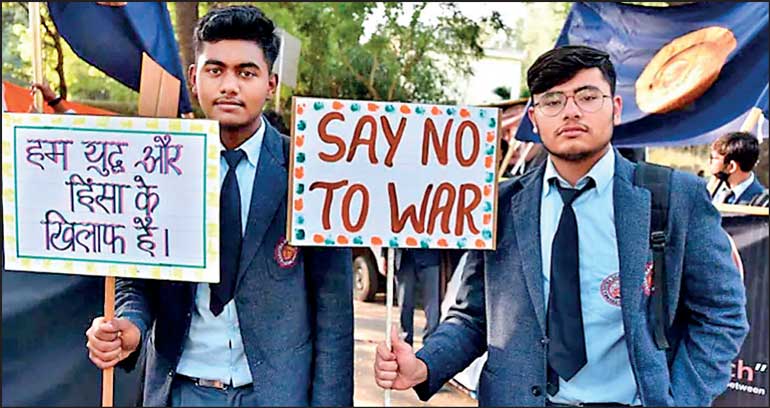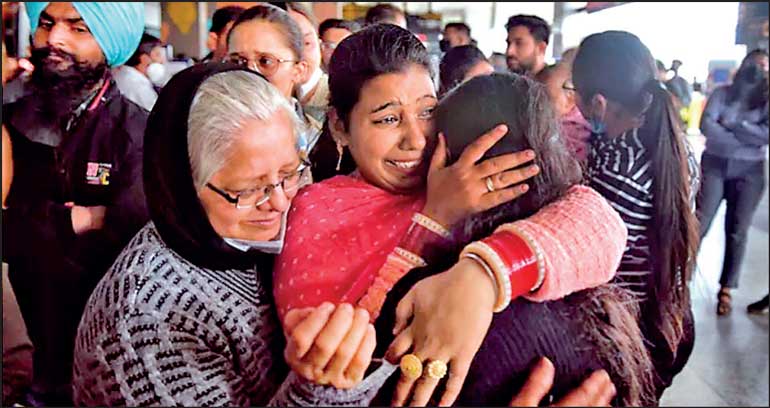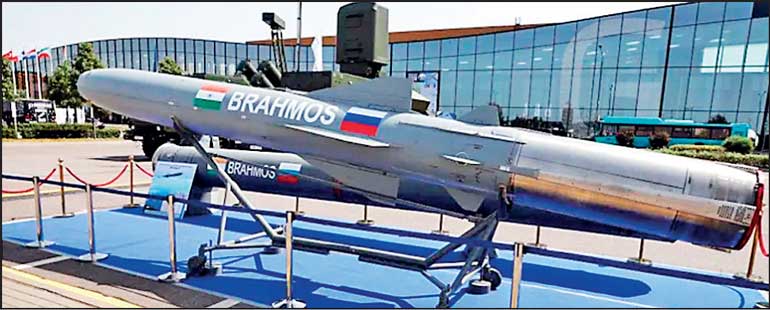Friday Feb 07, 2025
Friday Feb 07, 2025
Thursday, 10 March 2022 00:00 - - {{hitsCtrl.values.hits}}

Social activists, school/college students and members of the Gandhi Mandela Foundation call for an end to the war between Russia and Ukraine at Jantar Mantar, on 3 March, in New Delhi, India. Credit – Sonu Mehta/Hindustan Times via Getty Images

Parents welcome Indian students evacuated from Ukraine, at Terminal 3, Indira Gandhi International Airport on 3 Mar., in New Delhi, India. Sanchit Khanna/Hindustan Times via Getty Images

A BrahMos medium-range ramjet supersonic cruise missile, bearing Indian and Russian flags, on display at the 10th International Maritime Defense Show in St. Petersburg on 23 June, 2021. Alexander Demianchuk TASS via Getty Images

US President Joe Biden (R) and Indian Prime Minister Narendra Modi participate in a bilateral meeting in the Oval Office of the White House on 24 Sept. 2021 in Washington, DC. Sarahbeth Maney—Pool/Getty Images
By Debasish Roy Chowdhury
On 1 March, Naveen S. Gyanagoudar left his bunker in Ukraine’s second city, Kharkiv, to get food, when he was killed in Russian shelling. The 22-year-old undergraduate was among the thousands of Indian students trapped in Ukraine awaiting evacuation.
His death has highlighted their plight, while bringing home to India the immediacy of a faraway war. It has also underscored the importance of India’s neutrality in the conflict. On Wednesday, the Russian ambassador to India announced that Moscow would investigate Gyanagoudar’s death and work on a “humanitarian corridor” for evacuating Indian students.
The concession has much to do with Delhi’s studious defiance of the Western expectation that it throws its weight behind punitive actions against Russia. Prime Minister Narendra Modi has phoned Russian president Vladimir Putin and reiterated the hope for a cessation of violence and a return to dialogue. He phoned Ukrainian president Volodymyr Zelensky and said the same thing.
India was among only three countries, and the only democracy, in the UN Security Council to abstain from a 26 February vote on the US-sponsored resolution deploring Russia’s actions in Ukraine. (The other two abstainers were China and the United Arab Emirates.) It called for restraint on all sides, while avoiding any reference to Ukrainian sovereignty or territorial integrity. On 2 March, India again abstained from voting against Russia in the 193-member UN General Assembly. Two days later, it abstained from a crucial vote at the United Nations Human Rights Council seeking a probe into rights violations in Ukraine amid the war.
Predictably, Russia has welcomed India’s “independent and balanced” stance. But it hasn’t gone down too well with the Western votaries of a supposed global axis of democracies against illiberalism. In a co-written opinion piece for an Indian news outlet, Stephen Biegun, a former US deputy secretary of state, complained: “Those guiding Indian foreign policy surely must understand that this is a fight to defend democracy from authoritarianism.” There was still time, he said, “for the true voice of a democratic India to be heard. The world is listening.”
India’s close ties with Russia
India has some very good reasons for its silence on Ukraine. Russia is India’s biggest arms supplier. Even though the degree of reliance is not what it was in previous decades, 70% of India’s armed forces systems are still of Russian origin. According to the Stockholm International Peace Research Institute, Russia accounted for nearly half of India’s arms imports between 2016 and 2020.
In December, Modi and Vladimir Putin signed a flurry of trade and arms deals, including a 10-year military and technical cooperation program that will see India produce half a million Kalashnikov assault rifles. India already builds BrahMos supersonic cruise missiles with Russia and has bought the crucial S-400 air defence system from Moscow as a strategic deterrence against Pakistan and China.
Outside of defence, a Russian state-owned enterprise is building India’s biggest nuclear power plant. Energy-hungry India, the third largest oil importer after China and the US, is also counting on Russian oil and gas to boost its economy. In recent energy deals, which are expected to triple annual trade between the two by 2025 from the current $ 11 billion, India has secured uninterrupted supplies of Russian coal; signed a contract with Rosneft for up to 2 million tons of oil this year; will invest in Russian oilfields and LNG projects; and mine coking coal in Russia’s Far East.
The close economic partnership mirrors the two countries’ historical camaraderie in geopolitics. The erstwhile Soviet Union served as the socialist role model for pre-liberalisation India, as well as a powerful hedge against adversarial American influence in South Asia. Moscow has always steadfastly backed India in global forums, especially in its territorial disputes with arch rival Pakistan over Kashmir.
During the Richard Nixon era, Pakistan’s facilitation of US rapprochement with China only entrenched India more firmly in the Soviet camp. So did Nixon’s personal animus against Indians—colourfully described by the president, and aide Henry Kissinger, as “a slippery, treacherous people,” “bastards,” and “the most aggressive goddamn people around,” in declassified White House tapes.
Moscow has never flinched from providing New Delhi critical military support when needed. It even risked a war with the US by sending its navy to the Indian Ocean to drive back a warship that Nixon had sent to intimidate India during its 1971 war with Pakistan. In subsequent decades, when the US sided with Pakistan to arm jihadis fighting the Soviet occupation of Afghanistan, New Delhi continued to draw support from Moscow.
A track record like that makes Russia a time-tested ally not just for India’s ruling establishment but also in the eyes of the Indian public. The latter fact alone would make it politically untenable for any Indian leader—even someone as powerful as Modi—to alienate Russia.
Putin’s appeal to the Hindu far right, Modi’s core support base, makes it all the more difficult. Despite the distress of Indian students stranded in Ukraine, Indian social media is thus by and large supportive of Delhi’s neutrality. The support for Russia cuts across political boundaries; no opposition party is demanding that Modi join the West in isolating Putin.
Neither would this be the first time India has refused to join global outrage against Moscow. Under the previous Congress party-led government, Delhi absented itself from Western condemnation of Russia’s annexation of Crimea in 2014, on the grounds that Russia had legitimate interests in Ukraine. Further back, in 1980, India opposed a UN resolution condemning the Soviet Union’s invasion of Afghanistan.
US overlooking Delhi’s neutrality on Ukraine
Geopolitical pressure not to ruffle Russia has since increased manifold because of China’s rise. India and China share a disputed border over which they fought a war in 1962. A carefully calibrated détente has since normalised relations, but has come under fresh strain and border flare-ups, at times lethal, have become frequent of late.
As India’s power asymmetry with China has increased over the years, and China has become more assertive in projecting its ascent, India’s insecurity has increased. In a complete reversal of its earlier policy of non-alignment, it has progressively tightened its embrace of America as a distant ally to hedge against its near foe. China, on its part, has come to see India as part of the US design to encircle it.
In Russia’s cordial relations with China, India also sees a moderating influence on, and a bridge with, China to manage their many differences. A strategic relationship with Russia also prevents Moscow from drifting entirely toward Beijing, which would be a disaster for India. Much to the horror of Indian policymakers, this is exactly what the wholesale sanctions on Russia may be achieving as they push Russia into a corner. The last thing India would want to do at this very moment is to abandon Russia and create even more difficulties for itself by strengthening a Sino-Russian entente.
So, it’s a no-brainer for Modi to sit this one out. Compared to the steep risks of joining the chorus against Putin, inaction entails little cost. The US will tend to overlook India’s hedging for the same reason it ignores India’s dangerous descent into illiberalism: it’s too important an ally. After all, in Modi, the US has an Indian leader with both the inclination and the ability to advance the strategic and economic partnership further than ever before.
That’s why, even as India draws criticism from US lawmakers for not taking a clear stance against Russia, the Biden administration itself refrains from pulling it up. The State Department reportedly recalled a strongly worded cable to US diplomats that asked them to take to task their counterparts from India and the UAE over their position on Ukraine.
Just as India can’t afford to lose Russia, the US can’t afford to lose India. They need each other, to face off against the ultimate challenger to America’s global dominance, which is China. Russia neither has the ambition nor the capacity to mount such a challenge. India’s condemnation of Russia will make little material difference to isolating Moscow. But its value in containing China is another matter. That is why India, along with Australia and Japan, is part of the US-led, four-nation Quadrilateral Security Dialogue, or Quad, aimed as a regional counterweight to China.
Russia may have taken centre stage in American threat perception for the moment—in his State of the Union Speech, President Joe Biden mentioned Russia 18 times and China just twice—but this crisis is part of a much bigger contest that has China at its heart. A contest that makes India indispensable for the US when the focus returns to China.
(Source: https://news.yahoo.com/why-u-doesnt-mind-indias-015431994.html)